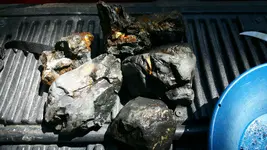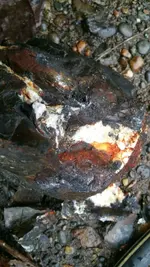Heres my knowledge dump on sulfides. Some material for brainstorming and food for thought.
Sulfide ores in order of prevalence in my district:
Iron sulfides ~50%
Lead sulfides ~17.5%
Zinc sulfides ~ 12.5 %
Arsenic sulfides ~ 10%
Copper sulfides ~ 10%
In order of reactivity to natural oxidative processes (sunlight, water, oxygen, bacteria) Most reactive to least reactive:
1) Iron Sulfides (FeS) "Iron pyrite"
2) Arsenic Sulfides (AsS, FeAsS) "Arsenopyrite"
3) Zinc Sulfides (ZnS) "Sphalerite"
4) Copper Sulfides (Cu[SUB]x[/SUB]S[SUB]y[/SUB], and Cu5FeS4) X and Y values range a broad spectrum from 1 to 39 " chalcocite, covellite, bornite, others, ect"
5) Lead sulfides (PbS) "Galena" Almost always contains traces of silver disseminated within the matrix ranging from trace values to 1% by weight
Sulfide ores react slightly differently when exposed to oxygen, water, and natural processes based on my observation.
When I mean react I mean, rot, or oxidize. Some sulfides crumble, crack and exfoliate, opening up the inner un-oxidized layers causing it to rot.
Others form a passivization layer after the outer surface oxidizes leaving the inner sulfide encased in a water proof, oxygen proof environment.
-Iron and Arsenic sulfides react fairly similarly. They appear to decompose at similar rates and rot through quite thoroughly with enough exposure to the natural processes (O2, H20, sunlight, natural bacterial processes). As long at they are not encased in water proof, airtight host rock they crumble and exfoliate all the way and do not form impenetrable passivization layers
Lead sulfides
-Zinc sulfides. Not a lot of experience observing them but it appears they also form a passivization layer to some extent but not to the same extent as lead sulfides. Zinc sulfides appear to crumble apart (rot) eventually, but much more slowly.
-Copper sulfides. I don't have enough observation to say definitively but it appears that all factors equal they oxidize at a less rapid rate than iron and arsenic sulfides. Can't say definitively based on my observation but I don't think they form impenetrable passivization layers.
-Lead sulfides DO form a passivization layer. Once the exposed sulfide layer rots away a layer of metallic/ oxidized layer of lead is leftover that effectively inhibits further oxidation.






